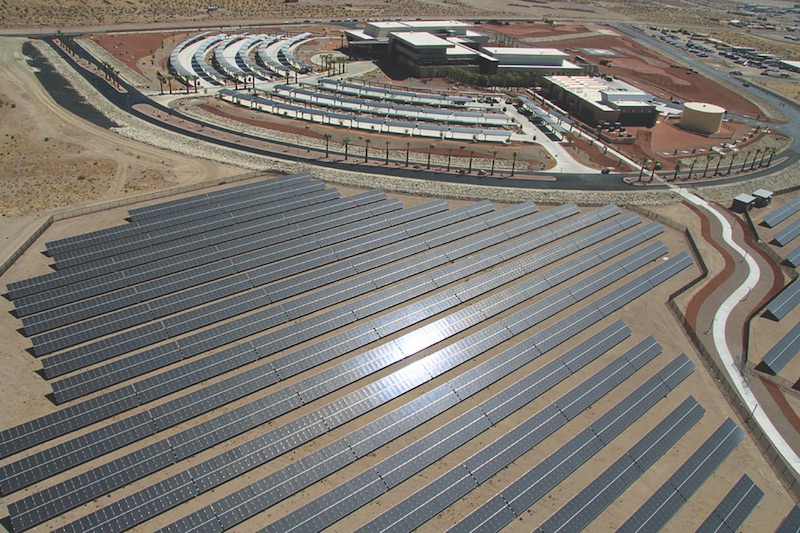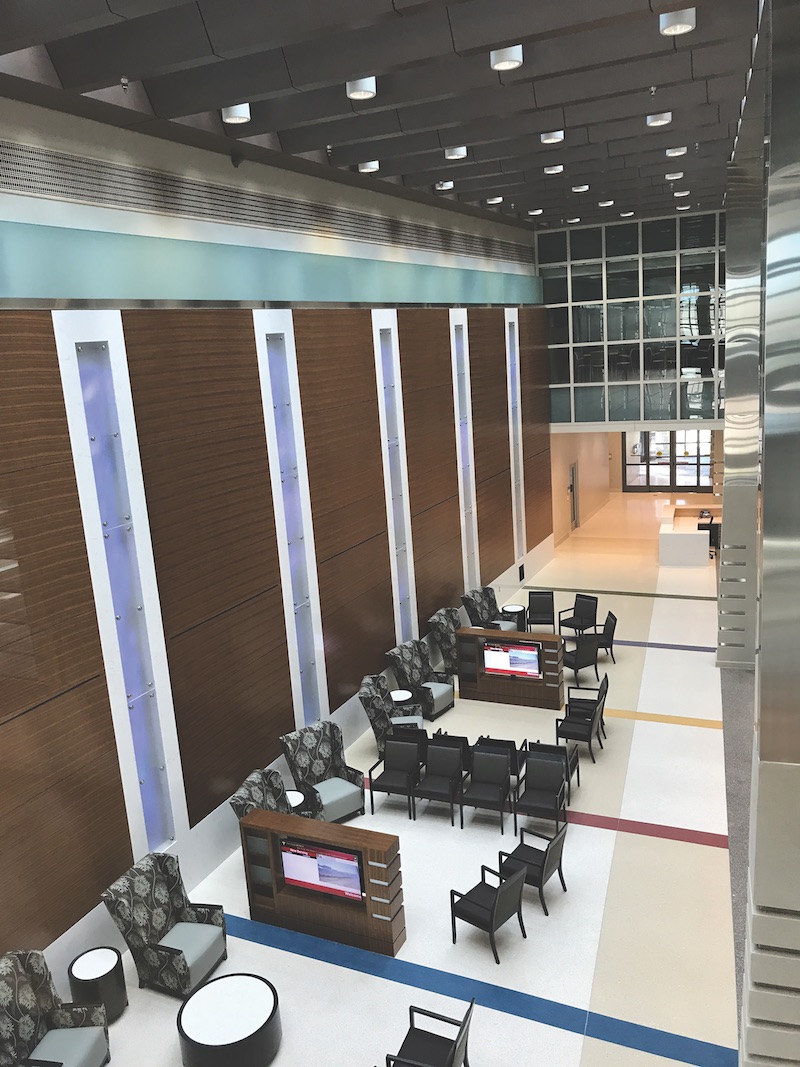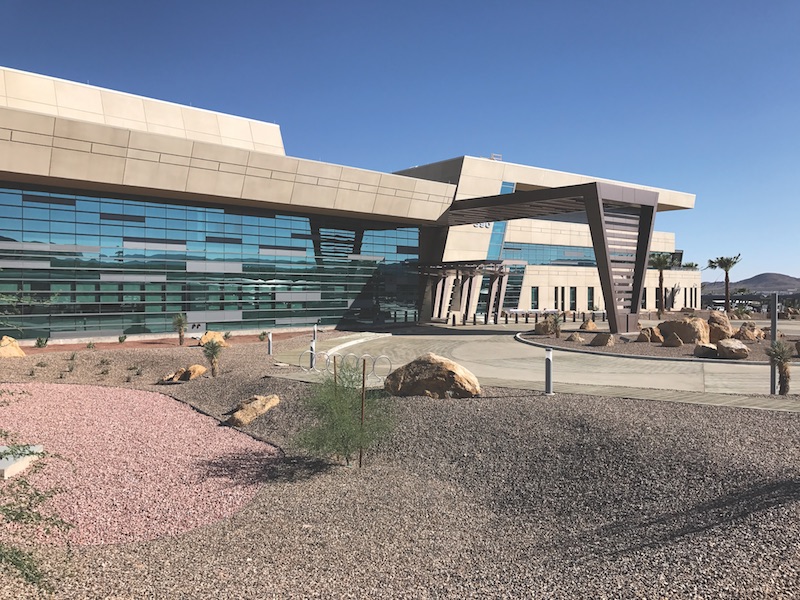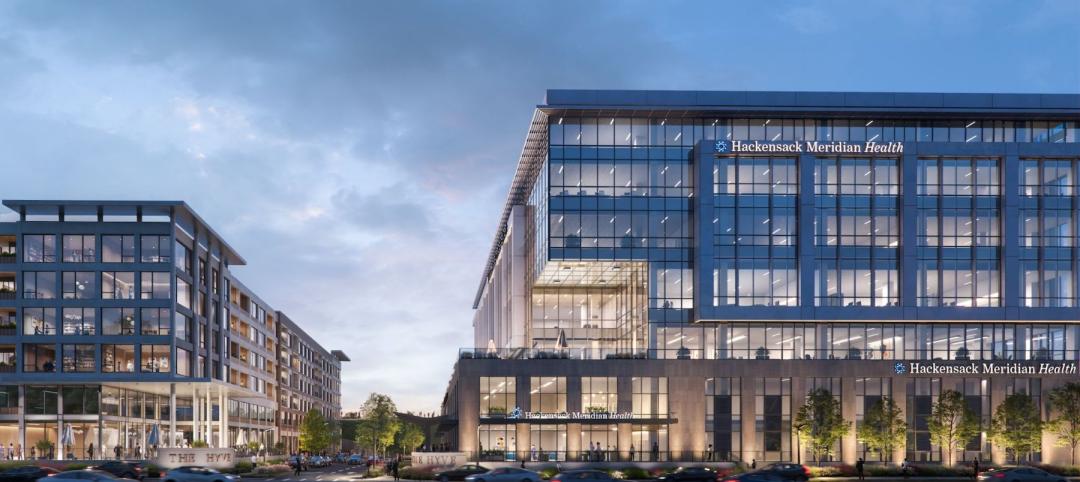Every year thousands of troops get live-fire training at the Army’s National Training Center, Fort Irwin, Calif. The soldiers and the more than two thousand military families (two-thirds of which have children) on the post will now benefit from having the first net-zero energy, carbon-neutral hospital in the country, and only the third LEED Platinum hospital in the world.
The recently completed Weed Army Community Hospital, designed by the joint venture team of RLF/Ellerbe Becket and built by Turner Construction Company, replaced an outdated 51-year-old medical facility. The new 217,000-sf facility has 55 exam rooms in two clinic wings and a 15-bed hospital. It is distinguished by a gigantic horseshoe-shaped, 2.4MW fixed-panel photovoltaic array that spreads across five acres.
Before giving a thought to PVs or other renewables, the project team explored passive design, engineering, and construction practices that would modulate the local climate. Fort Irwin lies 37 miles northeast of Barstow, in the Mojave Desert. Average daily temperatures can range from 114 to -14 Fahrenheit.
 The 2.4MW PV array provides virtually all the power needs for the Weed Army Commnity hospital, clinic, and central utility plant. The $162 million facility won an Honor Award for Conceptual Design from the U.S. Army Corps of Engineers. Photo: Steven M. Langston, AIA, Design Director, RLF.
The 2.4MW PV array provides virtually all the power needs for the Weed Army Commnity hospital, clinic, and central utility plant. The $162 million facility won an Honor Award for Conceptual Design from the U.S. Army Corps of Engineers. Photo: Steven M. Langston, AIA, Design Director, RLF.
David Fishel, RLF’s Senior Energy Analyst, says the project team used seven major energy-efficiency measures that only added “a few percent” to the budget and had a payback of less than 10 years (the building’s projected lifespan is 25 years).
To reduce the energy load, the first floor of the hospital was built into a hillside. Daylight reaches 90% of occupied spaces. Insulation in the roof, walls, and floors was beefed up. High-efficiency condensing boilers and water heaters were specified, as were occupancy controls and variable frequency drives.
Turner Construction diverted 75% of construction and demolition waste from landfill and remediated the brownfield site. Bio-retention basins and open stone-lined ditches were installed for stormwater retention; the four inches of annual rain provide all the water needed for the site’s xeriscape plantings.
These and other measures brought the replacement hospital’s energy use 33% below the ASHRAE baseline and moved it closer and closer to carbon neutrality. Only then did the project team start thinking about designing a cost-effective strategy for the use of renewables.
 The lobby of Weed Army Community Hospital features a simulated waterfall element that uses lights, images, and sounds to emulate the experience of falling water. More than two thousand families, most of them with children, live on the post. Photo: Steven M. Langston, AIA, Design Director, RLF.
The lobby of Weed Army Community Hospital features a simulated waterfall element that uses lights, images, and sounds to emulate the experience of falling water. More than two thousand families, most of them with children, live on the post. Photo: Steven M. Langston, AIA, Design Director, RLF.
The Army requires LEED Silver certification for new projects, but the project team was not content to stop there. The hospital earned 82 of 110 possible LEED points to achieve a Platinum rating. Ten were bonus points—six for innovation and design, mostly for the PV array, but also for instituting a green maintenance program; and four were earned for overcoming “regional priority” factors, such as water scarcity.
The $162 million hospital is resilient, too. Thanks to climate conditions that are nearly perfect for solar-based systems—extremely high solar irradiance and virtually no cloud cover—the hospital will probably never be short of electricity. A solar water heating system satisfies 65% of domestic hot water demand. It also has a 550,000-gallon water storage tank, an underground sewage storage capacity of 475,000 gallons, and 50,000 gallons of diesel fuel storage.
“The hospital can operate for more than two weeks in the event all utilities are severed,” says Jeff Williams, Project Executive, Turner Construction.
Related Stories
Healthcare Facilities | Apr 16, 2024
Mexico’s ‘premier private academic health center’ under design
The design and construction contract for what is envisioned to be “the premier private academic health center in Mexico and Latin America” was recently awarded to The Beck Group. The TecSalud Health Sciences Campus will be located at Tec De Monterrey’s flagship healthcare facility, Zambrano Hellion Hospital, in Monterrey, Mexico.
Healthcare Facilities | Apr 11, 2024
The just cause in behavioral health design: Make it right
NAC Architecture shares strategies for approaching behavioral health design collaboratively and thoughtfully, rather than simply applying a set of blanket rules.
Healthcare Facilities | Apr 3, 2024
Foster + Partners, CannonDesign unveil design for Mayo Clinic campus expansion
A redesign of the Mayo Clinic’s downtown campus in Rochester, Minn., centers around two new clinical high-rise buildings. The two nine-story structures will reach a height of 221 feet, with the potential to expand to 420 feet.
Products and Materials | Mar 31, 2024
Top building products for March 2024
BD+C Editors break down March's top 15 building products, from multifamily-focused electronic locks to recyclable plastic panels.
Healthcare Facilities | Mar 18, 2024
A modular construction solution to the mental healthcare crisis
Maria Ionescu, Senior Medical Planner, Stantec, shares a tested solution for the overburdened emergency department: Modular hub-and-spoke design.
Healthcare Facilities | Mar 17, 2024
5 criteria to optimize medical office design
Healthcare designers need to consider privacy, separate areas for practitioners, natural light, outdoor spaces, and thoughtful selection of materials for medical office buildings.
Healthcare Facilities | Mar 15, 2024
First comprehensive cancer hospital in Dubai to host specialized multidisciplinary care
Stantec was selected to lead the design team for the Hamdan Bin Rashid Cancer Hospital, Dubai’s first integrated, comprehensive cancer hospital. Named in honor of the late Sheikh Hamdan Bin Rashid Al Maktoum, the hospital is scheduled to open to patients in 2026.
Sports and Recreational Facilities | Mar 14, 2024
First-of-its-kind sports and rehabilitation clinic combines training gym and healing spa
Parker Performance Institute in Frisco, Texas, is billed as a first-of-its-kind sports and rehabilitation clinic where students, specialized clinicians, and chiropractic professionals apply neuroscience to physical rehabilitation.
Healthcare Facilities | Mar 7, 2024
A healthcare facility in New Jersey will be located at a transit station
The project is part of a larger objective to make transportation hubs more multipurpose.
University Buildings | Feb 21, 2024
University design to help meet the demand for health professionals
Virginia Commonwealth University is a Page client, and the Dean of the College of Health Professions took time to talk about a pressing healthcare industry need that schools—and architects—can help address.

















